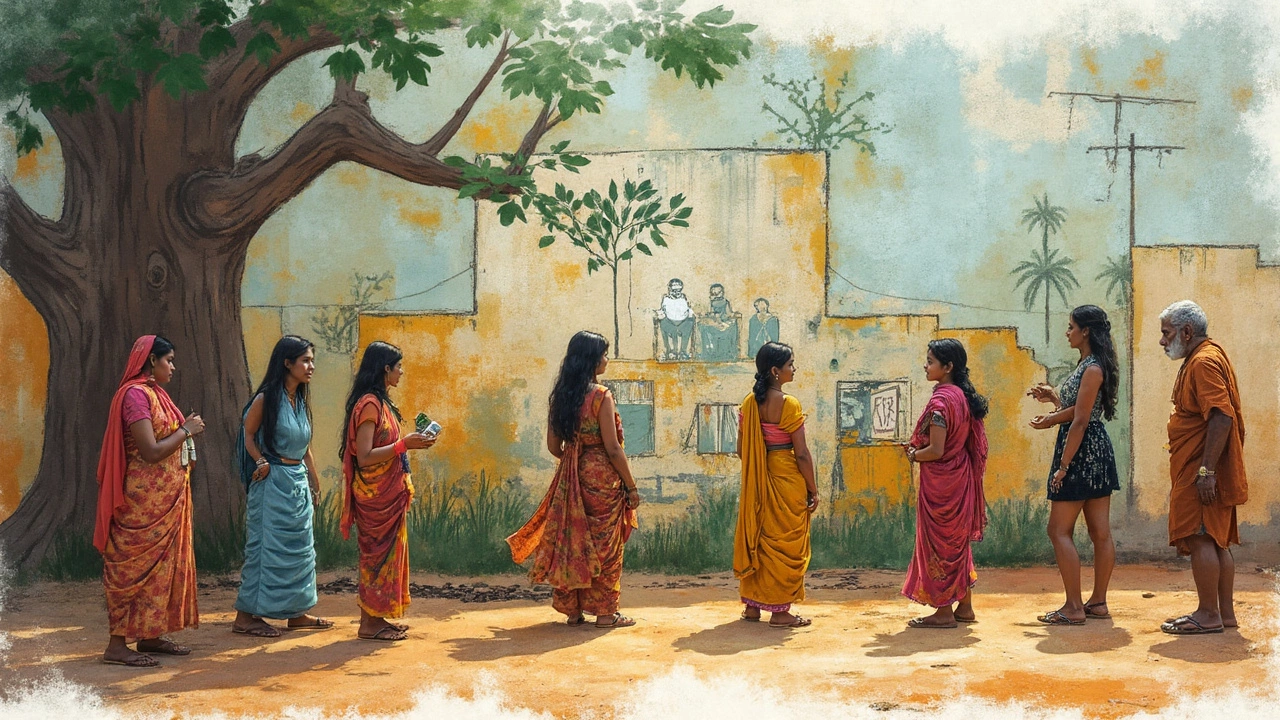
Everyone talks about wanting a better India, but it’s easy to get distracted by what’s not working. The real magic happens when people focus on what can actually be changed. A vision for India isn’t just a pretty poster or a line in a school essay—it’s a list of things we can start doing right now, even if it feels small or messy at first.
One basic fact: India has the world’s largest youth population, and that’s a powerhouse. Imagine what would happen if every young person felt empowered to fix things in their own street or school. It’s not a fantasy—change starts with that one bold step. If you’re dreaming big but don’t know where to start, try volunteering in a local cleanup drive or mentoring someone younger than you. It’s okay to start local; in fact, that’s where most real change begins.
Inspirational quotes are everywhere, but the best ones are those that push you to act. Think of Dr. APJ Abdul Kalam’s words, “Dream, dream, dream. Dreams transform into thoughts and thoughts result in action.” The action part matters most. If you like putting up quotes on your wall or screensaver, pick something that kicks you out of your comfort zone—nothing happens by waiting for someone else to fix it.
- Time to Reimagine Success
- Youth at the Heart of Change
- Break Free from Old Mindsets
- Action Steps for an Inspired India
Time to Reimagine Success
When you ask most people what it means to "make it" in India, the answers are usually about a big job, a fancy car, or settling abroad. But is that really all there is? Success needs a new yardstick—one that matches what India actually stands for and cares about. Instead of just chasing money or status, more and more young Indians are giving their time, skills, and ideas to things that help everyone, not just themselves. That’s a real shift, and it’s happening right now.
Take startups, for example. India produced over 100 unicorns—private companies valued at $1 billion or more—by 2023. But the buzz isn’t just about becoming rich. Lots of these startups focus on problems no one else bothered to solve: farmers losing out on fair prices, school kids needing better resources, or small shops moving online for the first time. These changes mean we don’t have to define greatness as scoring a government job or working only in IT anymore.
Another cool shift—people are starting to care about impact. Here’s something to think about: the Swachh Bharat Mission, launched in 2014, led to over 100 million toilets being built across rural areas. That’s not glamorous, but it changed lives for millions, especially for women and kids. If you want your story or your family's story to make a mark, think about what kind of problems you want to help fix, not just where you want to work.
- If you're in school or college, look out for projects that make your city cleaner or safer.
- If you're working, use your role to improve workplaces, help new people get trained, or boost fair practices.
- Don’t be shy to talk openly about what success means to you, even if it's totally different from what your parents expect.
The vision for India isn’t about copying others. It's about raising the bar on success until it means making things better for as many people as possible. The world isn’t looking for another copy-paste country—India does best when it sets its own goals and redefines what winning really looks like.
Youth at the Heart of Change
Here’s the thing: India is home to more than 370 million young people (aged 15-24), which the UN straight-up calls the “largest youth cohort in the world.” That’s serious potential if you want to shake things up and get the country moving in a better direction. Young folks are already making their mark in tech, politics, sports, and even social work—just look at things like Indian startups breaking records or 20-somethings leading Internet awareness campaigns.
According to an ASER 2023 report, tech adoption among rural youth is up by 22% compared to 2020. Coding clubs, language courses, online skills training—they’re not just for show. This isn’t about waiting for government schemes to fall in your lap; it’s about learning what you can, teaching what you know, and pushing your friends to do the same.
| Area | Stat (Ages 15-24) | Source |
|---|---|---|
| Population | 370+ million | UN Data (2024) |
| Internet Usage | 82% | TRAI, March 2025 |
| Skill Training Uptake | 32% | NSDC, 2024 |
| Entrepreneurship Intent | 1 in 4 youth | India Youth Survey, 2025 |
People love to say, “What can one person do?” But, actually, every youth-led movement—whether it’s climate change, digital literacy, or even local clean-up drives—started with one person sick of complaining. Simple steps count. Start a petition. Set up a peer study group. Volunteer for local issues. None of this needs permission from anyone.
Vision for India isn’t just talk—it’s who shows up and what they do every day. If you’re not sure where to begin, pick one small thing that bugs you, grab a couple of friends, and see how far you can push it. Big change doesn’t wait for a job title or some “leader” to appear.
"The future belongs to those who believe in the beauty of their dreams." – Eleanor Roosevelt
Dreaming is great, but moving from big ideas to day-to-day action is what gives India’s youth the edge. Get organized, get vocal, and use tech to build the momentum. The world is already watching.

Break Free from Old Mindsets
If you look around, a lot of problems just stick around because people are stuck thinking, “This is how it’s always been.” It’s honestly one of the biggest roadblocks when you talk about a vision for India that actually changes lives. You see it everywhere—whether it’s how careers are chosen, how women are treated at work, or even how people react to someone starting a business instead of choosing a ‘safer’ job.
Did you know that according to a 2024 NITI Aayog report, only 24% of Indian women above 15 are in the workforce? A big reason is how people see women’s roles. It’s not because skills or money are missing—it’s about old ideas sticking around in families and offices.
Mindset isn’t just about gender, though. Innovation can get bogged down by the “chalta hai” attitude (basically, ‘it’s fine the way it is’). This stops bright young people and older experienced folks from even suggesting changes. Anything from garbage segregation at home, to speaking up against bribes, can improve if people decide to ditch “this is how my parents did it.”
“Change does not roll in on the wheels of inevitability, but comes through continuous struggle.” – Dr. Martin Luther King, Jr.
Want to actually break old molds? Here’s how:
- Start calling out outdated ideas, even with friends and family. Being honest helps, even if it’s awkward at first.
- Push for more inclusive spaces, whether in school clubs, offices, or even online groups. Everyone needs a spot at the table.
- Try new things. Help out at a tech workshop, join a local government meeting, or just ask questions that push for answers.
People don’t have to tackle the whole country at once. Each big move is just a series of small steps where someone chooses to challenge an old idea—then backs it up with action. Check out the data below. It shows how real change starts with breaking away from habits.
| Mindset Barrier | Area Impacted | Change When Overcome |
|---|---|---|
| Gender Roles | Workforce Participation | +50% more women in senior roles (source: McKinsey 2023) |
| Fear of Failure | Startups and Innovation | More successful young founders (Startup India report) |
| “Chalta Hai” Attitude | Public Projects | Cleaner cities and faster delivery of services |
Action Steps for an Inspired India
If you really want to make your vision for India a reality, it’s about rolling up your sleeves—not just dreaming. Here’s where the rubber meets the road: real action, based on what’s proven to work.
First, let’s talk local problems. Waste management keeps showing up on headlines because we still dump over 62 million tons of solid waste every year. Joining or organizing a neighborhood cleanup or a simple composting project can make a shocking difference. People often expect big reforms from above, but when folks actually separate waste at home, local governments notice. Cities like Indore are top-ranked for cleanliness because people took these small daily steps first.
Now, let’s get into education. There are always debates over what skills the youth should learn. But here’s the deal—tech jobs are growing, but so is the need for basic digital skills in every job. Free platforms like Digital India and Skill India Mission are out there—sign up, get certified, and help others do the same. If you have digital skills, you’re more employable, and so is your friend, cousin, or neighbor once you show them the ropes.
Next up, voting and civic action. India’s voter turnout is still just around 67%. If you’re old enough, make voting non-negotiable for yourself and encourage your group of friends to do it together. Each vote is a small but real nudge toward better local governance.
- Volunteer one day a month—pick any cause, from helping kids in slums with homework to planting trees on a city street.
- Share success stories, not just rants, on your social media. Spotlight improvements, like a plastic ban in Mumbai or rooftop solar on a local school. Positive peer pressure works way better than complaining.
- Get comfortable with learning and unlearning. Read up on inspiring Indians: Sonam Wangchuk’s DIY education hacks, or Arunachalam Muruganantham’s affordable sanitary pads. Their stories are living proof real change often starts with one stubborn person refusing to accept the status quo.
- Form small groups—change always starts with a handful of motivated people. Whether it’s for a clean-up drive or a new social business idea, people power multiplies fast.
Vision is wasted without action. India won’t look different unless we do things differently. So, the next time you see something broken—fix it if you can, and if you can’t, join up with others who will. That’s how we get the India we all keep dreaming about.